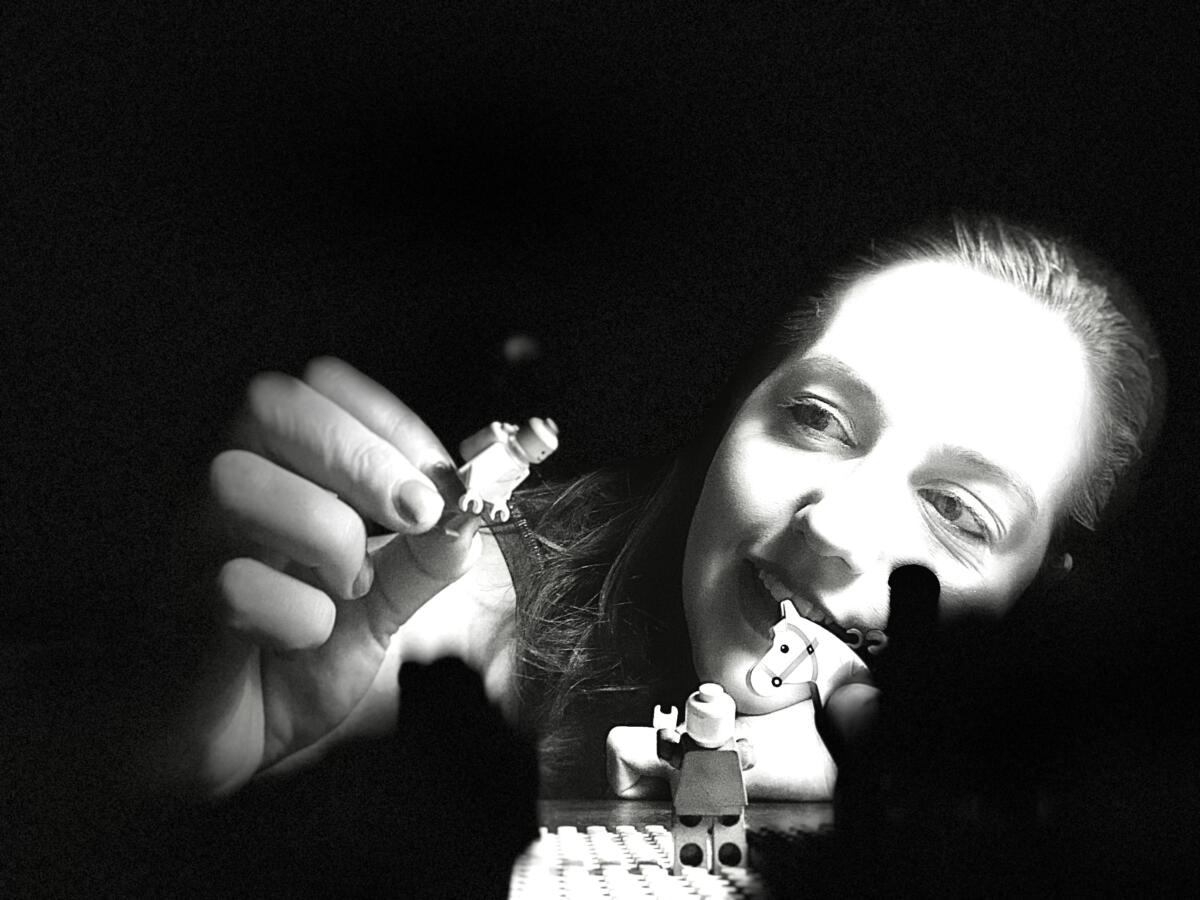Program: It Takes a Child’s Imagination

Monodrama for singer and chamber ensemble by Niki Main
Duration: 40 minutes
Premiered on June 5th, 2024 at Sonore Hall, Musiikkitalo, Helsinki
Written for Yolanda Harding
Artistic team
Libretto & Composition: Niki Main
Director: Yolanda Harding
Directing consultant: Martina Roos
Conductor: Elisar Riddelin
Lighting designer: Jukka Kolimaa
Set Design: Yolanda Harding
Visual Art: Yolanda Harding & Alissia
Ensemble
Soprano: Yolanda Harding
Narrator: Niki Main
Accordian: Sabina Aftyka
Clarinet: Gracia Ortega Navarro
Bassoon: Aaro Lehtovaara
Double Bass: Tuomo Matero
Percussion: Teo de la Cruz

Introduction
From the world of “Alice in Wonderland” we give you a new story based around Lewis Carroll’s unusual children’s poem, “The Hunting of the Snark”. Set in a child’s bedroom, this fantastical story takes the audience on a ride through a child’s imaginary adventure overseas in pursuit of finding the allusive creature: the Snark. Yet, ‘Fear’ is always watching and takes every opportunity to disrupt their journey. Will the child escape Fear’s grasp?
This wacky monologue opera has been composed this year for Yolanda Harding’s master’s concert by composer, singer, and poet Niki Main and it will have its premiere on June 5th, 2024. The piece is a commentary on how most fears we have as adults are placed upon us during childhood by society and during this process, we lose our ability to create and play without judgement. This is an ongoing project by Main and Harding; the performance today is a minimalist demonstration of the larger opera currently in the works. We have designed this opera in a way that allows it to be performed in many different formats; for example, a simple concert/radio play, piano reduction for chamber concerts or a fully stage performance with actors and dancers included. We wanted there to be options to incorporate various art forms into the performance. In this minimalist version we have ‘scrapbook’ projects as snippets of the child’s imagination. However, in the larger work we wish to have actors, dancers and commission a professional visual artist.
Yolanda Harding

Yolanda Harding is a British-Finnish Soprano, who will graduate this summer with her Master’s degree in Vocal Art studies from the Sibelius Academy. In 2022, Harding she debuted various roles including: ‘Jenny’ in the Finnish premiere of Ned Rorem’s opera, “Three Sisters Who Are Not Sisters,” ‘Erste Dame’ in the Sibelius Academy’s production of Mozart’s, “Die Zauberflöte”. She also performed as the soprano soloist in Mendelssohn’s “Paulus Oratorio” with the Kuopio Choir and Orchestra. Harding’s impact extends beyond the stage. She’s a dedicated advocate for the arts community, actively participating in initiatives that aim to shape the future of art and culture in Finland. Her role as Vice Chair (2023) of the Student Arts Board (TaiYo) at the University of Arts exemplifies her commitment to improving communication and creating a vibrant artistic environment for fellow artists. In addition to her performances and advocacy work, Harding is actively engaged in creating new musical dramas and pushing the boundaries of ‘traditional concert format.’ Last April she starred in a contemporary music-theatre piece titled ‘In winter, Necks are shorter,’ directed by Homa Shokri and this year she performed her own art piece, inspired by Havis Amanda, for the Vappu eve celebrations (30.4). Yet, today’s production is her most daring project and marks the start of a new era in her artistic career. After graduation, Harding takes off to Savonlinna Opera festival and then continues in Helsinki with various artistic projects (including a production at Helsinki Opera house, 2025). All of this would not have been possible without the generous support from the ‘Hélène och Walter Grönqvists,’ Selim Eskelin foundation and Sibelius Academy Foundation.
Elisar Riddelin

Conductor Elisar Riddelin is currently completing his studies under the guidance of Sakari Oramo in the conductor’s class at the Sibelius Academy. Previously, he has been mentored by Jorma Panula, Petri Komulainen, Ari Rasilainen, and B. Tommy Andersson.
Riddelin has conducted orchestras in Finland, as well as in Sweden and Germany, including the Swedish Radio Symphony Orchestra, the Norrköping Symphony Orchestra, the Rheinland-Pfalz Philharmonic, the Hofer Philharmoniker, the Gävle Symphony Orchestra, and the Dala Sinfonietta.
In the 2023-24 concert season, Riddelin will debut with the Helsinki Philharmonic Orchestra, and the orchestras of Lappeenranta, Jyväskylä, and Joensuu. In the fall of 2024, Riddelin will conduct the world premiere of Oscar-winning Elliot Goldenthal’s Othello Symphony, lead the final of the Porvoo Cello Competition, and make his debut with the Pori Sinfonietta.
Riddelin also enjoys working with youth orchestras and has performed several times with the national youth orchestra Vivo in Finland and the Royal College of Music orchestra in Sweden. He also founded the Caprico Orchestra, with which he has premiered over 20 new chamber orchestra works by young Finnish composers. Currently, he serves as the chief conductor of the salon orchestra Golden Monrepos.
Riddelin regularly collaborates with artists from other fields, including visual artists, ceramicists, and actors. He has received numerous grants and recognition awards. For instance, he was chosen as the Young Musician of the Year by the Pro Musica Foundation and has received support from the Finnish Cultural Foundation.
Niki Main

Niki Main is a countertenor, composer, and poet based in Finland and the US. They are currently pursuing their bachelor’s and master’s degrees at the Sibelius Academy where they study composition with Riikka Talvitie and voice with Ulla Raiskio. Recent projects include premieres with the Avanti! Chamber Orchestra, FRONT International Triennial, Musaics of the Bay, NYKY Ensemble, and as composer-performer at the Musica Nova Helsinki festival. Recent stage productions include: John Cage’s Songbooks at Viitasaaren Musiikin Aika with Joan La Barbara and the roles of Honour in Purcell’s King Arthur and Liberto, Lucano, Littore, and 2nd Famigliare in Monteverdi’s L’incoronazione di Poppea with the Sibelius Academy Opera.
Synopsis
Prologue: The Adult breaks free from the collective of a world without imagination. A cold and oppressive place. As they distance themselves from the collective words, thoughts and memories come back to them. They slowly regain their individuality and try to explain what is wrong with the world. Fear takes over the adult and brings them back to their childhood self.
The Story: A beautiful sunny day, the child awakes joyful. They make the mundane task of brushing teeth fun and exciting. Finding their favourite book they sit down to read and fill their room with wonder and imagination. The future is uncertain but THE CHILD (full of hope) contemplates what they would be like as an adult. FEAR creeps in and THE CHILD starts to worry about getting older… but they push FEAR aside as they have decided to be like THE BELLMAN! THE CHILDcontinues deeper into their imagination as they gather their crew and lead them through ‘tropical climes.’ After a marvellous speech. THE CHILD is at their favourite part of the story where they transform into THE BAKER to tell the ominous tale of the JOOBUM. A creature, unlike the Snark, is evil and upon finding you will make you vanish from time and space. Yet by the end of this tale FEAR has found a way into their bed and THE CHILD begins to lose their courage. A sleepiness suddenly takes over THE CHILD and they are pulled by FEAR to rest in bed. Finally FEAR has them! It seep into THE CHILD’s mind and make all happy memories tinted with fear. Ultimately changing the way THE CHILD will think. Awoken to a ‘furious bell’ THE CHILD searches round the room for noise that woke them. Fearful, they recite the last part of the story, hoping the words might inspire happier times. But FEAR has overtaken them and leaves them in darkness.
Epilogue: THE ADULT looks back at these memories with uncertainty. FEAR has managed to separate them from their imagination. They can no longer understand the words that were once so full of colour. THE ADULT has flashes of life and as they are about to reconnect… it is all lost again.
Instrumentation
Voice, “The Child”
Narrator, “FEAR”
Clarinet (doubling Bb and Bass)
Bassoon (with paper tube for low A)
Accordion (doubling Toy Piano)
Percussion (1 player)
Marimba
1 Timpano (low 29″, range: F to D)
2 Tubular Bells (pitches: A & B)
Kick Drum
3 Toms
Snare Drum
2 Bongos
3 Woodblocks
Suspended Cymbal
Splash Cymbal
Cowbell
Triangle
Thunder Sheet
Flexatone
Ratchet/Crank (1-handed)
Slapstick/Whip
Styrofoam/Cardboard (with bow)
Contrabass
Libretto (in English)
(Based on the poem “The Hunting of the Snark” by Lewis Carroll, 1876)
Characters:
Singer, referred to as “The Child”
Narrator, referred to as “FEAR”
Prelude: A World without Imagination (Wallace Stevens, The Comedian as the Letter C, 1923)
(Singer as adult self):
Severance
Was clear. The last distortion of romance
Forsook the insatiable egotist. The sea
Severs not only lands but also selves.
Here was no help before reality.
The imagination, here, could not evade,
It was the strict austerity of one vast, subjugating, final tone.
Prologue: The Little One Lost (William Blake, The Little Boy Lost, 1789)
(FEAR):
Father, father, where are you going
O do not walk so fast.
Speak father, speak to your little one
Or else I shall be lost,
The night was dark no father was there
The child was wet with dew.
The mire was deep, & the child did weep
And away the vapour flew.
Scene I: Floss brush rinse (Emily Cabarle, Floss brush rinse, 2021)
(The Child):
Something about a smile’s never-ending//
joy finds us where we are.
O I do love dental symmetry//
Between us lives
gums and jagged lines
and yet we’re blessed with more.
Hold my retainer
and just breathe
While I spit into the sink//
Laugh with me.
Building strong enamel
we keep through pasteless travels//
Brace ourselves//
and come close
as teeth.
Scene II: Story Time – The Landing
(The Child):
“Just the place for a Snark!” the Bellman cried,
As he landed his crew with care;
Supporting each man on the top of the tide
By a finger entwined in his hair.
“Just the place for a Snark! I have said it twice:
That alone should encourage the crew.
Just the place for a Snark! I have said it thrice:
What I tell you three times is true.”
The crew was complete: it included a Boots—
A maker of Bonnets and Hoods—
A Barrister, brought to arrange their disputes—
And a Broker, to value their goods.
A Billiard-marker, whose skill was immense,
And a Banker, engaged at enormous expense,
Had the whole of their cash in his care.
There was also a Beaver, that paced on the deck,
Or would sit making lace in the bow:
And had often (the Bellman said) saved them from wreck,
Though none of the sailors knew how.
There was One who was famed for the number of things
He forgot when he entered the ship:
His umbrella, his watch, all his jewels and rings,
And the clothes he had bought for the trip.
He had forty-two boxes, all carefully packed,
With his name painted clearly on each:
But, since he omitted to mention the fact,
They were all left behind on the beach.
The loss of his clothes hardly mattered, because
He had seven coats on when he came,
With three pair of boots—but the worst of it was,
He had wholly forgotten his name
He would answer to “Hi!” or to any loud cry,
Such as “Fry me!” or “Fritter my wig!”
To “What-you-may-call-um!” or “What-was-his-name!”
But especially “Thing-um-a-jig!”
“His form is ungainly—his intellect small—”
(So the Bellman would often remark)
“But his courage is perfect! And that, after all,
Is the thing that one needs with a Snark.”
He came as a Baker: but owned, when too late—
And it drove the poor Bellman half-mad—
He could only bake Bride-cake—for which, I may state,
No materials were to be had.
The last of the crew needs especial remark,
Though he looked an incredible dunce:
He had just one idea—but, that one being “Snark,”
The good Bellman engaged him at once.
He came as a Butcher: but gravely declared,
When the ship had been sailing a week,
He could only kill Beavers. The Bellman looked scared,
And was almost too frightened to speak:
The Beaver, who happened to hear the remark,
Protested, with tears in its eyes,
That not even the rapture of hunting the Snark
Could atone for that dismal surprise!
Scene III: What will I become? (William Wordsworth, My Heart Leaps Up, 1807)
(The Child):
Bells, Billiards, Bonnets, Boots?
O Beaver,
What will I become?
A baker, a banker, or a bass-bowing brute?
O what will I become?
My heart leaps up when I behold
A rainbow in the sky:
So was it when my life began;
But where, O where does it end?
Graphs, Gavels, Galas, Ghosts?
O Galaxies,
Where will I go?
To what will I grow?
Where will I go? to what will I grow?
…Will I grow?
Scene IV: Story Time II – The Bellman’s Speech
(The Child):
The Bellman himself they all praised to the skies—
Such a carriage, such ease and such grace!
Such solemnity, too! One could see he was wise,
The moment one looked in his face!
He had bought a large map representing the sea,
Without the least vestige of land:
And the crew were much pleased when they found it to be
A map they could all understand.
This was charming, no doubt; but they shortly found out
That the Captain they trusted so well
Had only one notion for crossing the ocean,
And that was to tingle his bell.
Then the bowsprit got mixed with the rudder sometimes:
A thing, as the Bellman remarked,
That frequently happens in tropical climes,
When a vessel is, so to speak, “snarked.”
But the danger was past—they had landed at last,
With their boxes, port…man…portman…Toes? and bags:
Yet at first sight the crew were not pleased with the view,
Which consisted of chasms and crags.
The Bellman perceived that their spirits were low,
And recited in musical tone
A speech quite grand, in a manner most unplanned,
But the crew would do nothing but groan.
“Come, listen, my men, while I tell you again
The five unmistakable marks
By which you may know, wheresoever you go,
The warranted genuine Snarks.
“Let us take them in order. The first is…
“For, although common Snarks do no manner of harm,
Yet, I feel it my duty to say,
Some are Boojums—“
Scene V: Story Time III – The Baker’s Tale
(The Child):
There was silence supreme! Not a shriek, not a scream,
Scarcely even a howl or a groan,
As the man they called “Ho!” told his story of woe
In an antediluvian tone.
“A dear uncle of mine (after whom I was named)
Remarked, when I bade him farewell—”
“Oh, skip your dear uncle!” the Bellman exclaimed,
As he angrily tingled his bell.
“He remarked to me then,” said that mildest of men,
‘If your Snark be a Snark, that is right:
“‘You may seek it with thimbles—and seek it with care;
You may hunt it with forks and hope;
You may threaten its life with a railway-share;
You may charm it with smiles and soap—'”
“‘But oh, beamish nephew, beware of the day,
If your Snark be a Boojum! For then
You will softly and suddenly vanish away,
And never be met with again!”
Scene VI: I’ll not fear, I will not weep (Emily Bronte, Faith and Despondency, 1846)
(The Child):
“But, I’ll not fear, I will not weep
For those whose bodies rest in sleep,
I know there is a brilliant shore,
Opening its ports for me and mine,
If I look out at the wide waters o’er
Beyond worldly tempests, raging wild,
There, there’s my Time
O, I’ll not fear, I will not weep
For those whose bodies rest in sleep.
(FEAR):
There was a child went forth every day,
And the first object they looked upon and
received with wonder or pity or love or dread, that
object they became,
And that object became part of them for the day or
a certain part of the day . . . . or for many years
or stretching cycles of years…
If that object were cheerful, the child would
become cheerful.
If that object were full with imagination, so would
the child be full of imagination.
But if that object were treacherous, so would the
child become.
(Walt Whitman, There was a child went forth every day, 1855)
Scene VII: The Child’s Nightmare (Wallace Stevens, The Comedian as the Letter C, 1923)
(FEAR):
“The child slept and dreamt…”
“and dreamt…”
Approaching… like a gasconade of drums,
Adulthood darkened in. The façade—youth,
As sullen as the sky, was swallowed up
In swift, successive shadows, dolefully.
The rumbling broadened as the light of spring fell.
The old wind, tempestuous clarion with heavy cry,
Came bluntly thundering, more terrible
Than the revenge of music on bassoons.
Gesticulating lightning, mystical imagination,
Made pallid, flittered. The child, here, took flight…
And thus the child dreamed, while the bellowing seemed
To grow every moment more clear:
Till they woke to the knell of a furious bell,
Which the Bellman rang close at their ear.
Scene VIII: Story Time IV – The Banker’s Fate
(The Child):
They sought it with thimbles, they sought it with care;
They pursued it with forks and hope;
They threatened its life with a railway-share;
They charmed it with smiles and soap.
And the Banker
Rushed madly ahead and was lost to their view
In his zeal to discover the Snark
But while he was seeking with thimbles and care,
A Bandersnatch swiftly drew nigh
And grabbed at the Banker, who shrieked in despair,
For he knew it was useless to fly.
He offered large discount—he offered a cheque
(Drawn “to bearer”) for seven-pounds-ten:
But the Bandersnatch merely extended its neck
And grabbed at the Banker again.
It is just as I feared!
(FEAR):
The Bandersnatch fled as the others appeared
Led on by that fear-stricken yell:
“Leave him here to his fate—” the Bellman cheered,
And solemnly tolled on his bell.
Scene IX: Story Time V – The Vanishing
(The Child):
They sought it with thimbles, they sought it with care;
They pursued it with forks and hope;
They threatened its life with a railway-share;
They charmed it with smiles and soap.
They shuddered to think that the chase might fail,
And the Beaver, excited at last,
Went bounding along on the tip of its tail,
For the daylight was nearly past.
“There is Thingumbob shouting!” the Bellman said,
“He is shouting like mad, only hark!
He is waving his hands, he is wagging his head,
He has certainly found a Snark!”
“It’s a Snark!” was the sound that first came to their ears,
And seemed almost too good to be true.
Then followed a torrent of laughter and cheers:
Then the ominous words “It’s a Boo—“
(All whisper):
“–jum!”
(FEAR):
In the midst of the word they were trying to say,
In the midst of their laughter and glee,
They had softly and suddenly vanished away—
For the Snark was a Boojum, you see.
Lewis Carroll, The Hunting of the Snark, 1876
Libretto (in Finnish)
Libretto (suomi)
It Takes a Child’s Imagination
(perustuu Lewis Carrollin runoteokseen “The Hunting of the Snark” 1876)
Suomentanut Alice Martin, 2013.
Hahmot:
Laulaja: “Lapsi”
Kertoja: “Pelko”
Preludi: Maailma ilman mielikuvitusta (Wallace Stevens, The Comedian as the Letter C, 1923)
(Laulaja aikuisena):
Ero Oli selvä.
Viimeinen romantiikan vääristymä,
Hylkäsi kyltymättömän egoistin.
Meri ei erottele vain maita vaan myös meidät.
Täällä ei ollut apua ennen todellisuutta.
Mielikuvitus, täällä,
ei voinut väistää,
Se oli jyrkkä ankaruus
yhdestä valtavasta, alistavasta, lopullisesta äänestä.
Prologi: Kadotettu (William Blake, The Little Boy Lost, 1789)
(PELKO):
Isä, isä, minne menet
Oi, älä kulje niin nopeaan.
Puhu isä, puhu pienellesi
Tai muuten eksyn kokonaan.
Yö oli pimeä, ei isää siellä
Lapsi oli aamukasteesta raikas.
Syvä oli suo
ja lapsi itki
Ja sumu häipyi kauas.
Kohtaus I: Langata, harjata, huuhtoa (Emily Cabarle, Floss brush rinse, 2021)
(LAPSI):
On jotain erityistä loputtomassa hymyssä
ilo löytää meidät juuri siitä, missä olemme
Oi, rakastan hammasrivien symmetriaa
Välissämme asuvat ikenet ja rosoiset rajat
ja silti olemme siunattuja enemmällä.
Pidä kiinni hammasraudastani ja hengitä vain
Kun syljen lavuaariin
Naura kanssani.
Rakennamme vahvaa hammaskiillettä
Me kestämme tahnattomina matkojemme aikana.
Valmistaudumme ja tulemme lähelle kuin hampaat.
Kohtaus II: Tarinatuokio – Rantautuminen
(LAPSI):
Oivallinen kraukipaikka! Huusi Päällikkö
Ja kelloansa kilisti ykskantaan.
Tukastansa laskettiin nyt mereen miehistö,
Ja vuorovesi kantoi heidät rantaan.
Oivallinen kraukipaikka! Toistan uudestaan;
Siitä saatte varmaan rohkeutta.
Oivallinen kraukipaikka, vielä kerrataan!
Kun kolme kertaa sanoo, se on totta.
Laivan koko miehistön oli Päällikkö pestannut.
Oli kengänkiillottaja yksi Plankki,
Kiitos Pipontekijän, ei päitä palellut,
Rahavarat hoiti kallis Pankki,
Kovapalkkaisena tuo mies heidän rahoistaan
Kuin omistansa Piti tarkkaa huolta,
Jotta Ahne Peluri ei biljarditaidoillaan
Olisi niistä voittanut yli puolta.
Palkattiin myös riita-asioitten varalta
Laivaan oma prokuraattori;
Ja tarvittiin mies arvioimaan retken varoja
Hankittiin siis Pörssimeklari.
Istuskeli nypläämässä laivan kannella
Pitsinnyplääjämajava. Päällikön mukaan
Se usein oli pelastanut haaksen rikosta,
Mutta miten – eipä tiennyt kukaan.
Yhden Maine syntyi siitä, kun hän unohti
Rantaan kaikki matkatavaransa,
Sormukset ja sateenvarjot, kellot, juveelit
Ja matkavaatteet vasta ostamansa.
Neljäkymmentäkaksi, niin hän oli laskenut
Laatikkonsa. Kunkin päällä nimi.
Mutta kun hän kellekään ei niistä maininnut,
Niin rannalle ne jäivät, koko rivi.
Matkavaatteet sinänsä eivät olleet tärkeät –
Seitsemän kun takkia oli yllä
Ja kolmet saappaat jalassa. Vaan myöskin nimensä
Hän oli unohtanut, paha kyllä.
Niimekseen hän Luuli, Jos vain joku huusi, Hoi,
Tai kiljui kovaa: katsos mokomaa,
Sipulipihvi paratkoon, tai Simpula soi!
Tai, Mikä ihme se nyt olikaan!
Hän ei ole Nero eikä siroliikkeinen
– Jos päälliköltä lausuntoa lainaa –
Mutta rohkeudessa hän on ylivertainen,
ja kraukijahdissa se juuri painaa!
Paakari hän oli, mutta leipälajinsa
Hän kertoi vasta aavan meren teillä:
Pullakranssi häihin oli ainut taitonsa.
Ei siihen ollut aineksia heillä.
Viimeiseksi joukkoon liittyi selvä ääliö,
Kun yksi pesti oli vielä auki.
Yhden aatteen mies – No hyvä! Tuumi Päällikkö –
Se yksi aate oli näet Krauki.
Pyövelinä olo oli hänen työtänsä.
Vaan merellä hän äityi kertomaan
Ainoastaan majavia pyövelöivänsä.
Päällikkö sai sätkyn kerrassaan.
Kohtaus III: Millaiseksi kasvan? (William Wordsworth, My Heart Leaps Up, 1807)
(The Child):
Kellot, biljardi, myssyt, saappaat?
Oi majava,
Mikä minusta tulee?
Leipuri, pankkiiri, vai bassoa jousella soittava karju?
Oi, mikä minusta tulee?
Sydämeni sykähtää
kun näen taivaalla sateenkaaren.
Niin oli elämäni alkaessa;
Mutta missä, oi missä se päättyy?
Graafit, mailat, juhlat, haamut?
Oi galaksit,
Minne menen?
Millaiseksi kasvan?
Minne menen? Millaiseksi kasvan?
…kasvanko?
Kohtaus IV: Tarinatuokio II – Päällikön Puhe
(LAPSI):
Kelloniekkaa Päällikköä kaikki kehuivat,
Hän oli aito, ryhdikäs ja jalo!
Ei tarvinnut kuin nähdä miten silmät hehkuivat,
Niin tiesi: viisaudesta kertoo palo.
Merikortti Päällikön se merta esittää,
Ei siinä ole hiventäkään maata.
Miehistökin riemukseen voi sitä ymmärtää,
Ja kartanlukutaito voidaan taata.
Hienoa, kun kapteeniin on täysi luottamus!
Kuultiin Casta meren ulapalla,
Että hänen mielestänsä hoituu purjehdus
Pelkkää kelloansa soittamalla.
Keulapuomi peräsimeen joskus sotkeutui;
Sekin riesa heidän Piti kestää.
Termi kuului että laiva silloin “Kraukeutui”
Tropiikissa se on paha estää.
Mutta vaarat vältettiin ja rantaan saavuttiin,
Vain hiukan vaivaa oli kapsäkeistä.
Maisema ei ollut ihan mitä toivottiin:
Se koostui rotkoista ja järkäleistä.
Purjehtijain pettymystä hoiti päällikkö
Pahan päivän vitsivarastollaan.
Pilapuheille vain voihkii koko miehistö,
Ja yhä murheellisempia ollaan.
“Hei maanmiehet, roomalaiset ja myös ystävät,
Korvianne lainatkaa nyt vähän!”
Lainaus meni perille ja hurraat kiirivät,
Eikä puhe suinkaan jäänyt tähän.
Kuulkaa tarkkaan! Viisi on siis tuntomerkkiä,
Viisi varmaa, täysin tieteellistä,
Joista aidon Krauen tuntee Krauen etsijä.
Näistä saatte hyötyä Jos mistä!
“Ottakaamme ne järjestyksessä. Ensimmäinen on…
Peruskrauet vaikka eivät mitään pahaa tee,
On niissä – siitä varoittaisin nyt –
Puijumeita –
Kohtaus V: Tarinatuokio III – Paakarin tarina
(LAPSI):
Hiiskahdusta kuultu ei, ei kiljahdustakaan,
Ei rääkäisyä, tuskin mylvähdystä,
Mies, ken tunsi nimen “Hei”, kun ryhtyi kuvaamaan
Kohtalonsa kurjaa erehdystä.
Rakas setäni, tuo Jolta nimenikin sain,
Hyvästellessäni mulle haastoi –
“Hyppää Yli sedät!” Huusi päällikkö nyt vain
Ja kilisti niin että korvaa raastoi.
“Setä haastoi näin”, vain jatkoi kiltti Paakari:
“Krauki Jos on Krauki, niin oolrait…
Käy sen kimppuun sormustimin ynnä sisulla,
Huolella ja pöytähaarukalla,
Säikytä se rautateiden osakekirjalla
Ja Hurmaa hymyllä ja saippualla.”
“Mutta varo, veljenpoika, poika paisteikas,
Kraukesi Jos Onkin Puijumi!
Silloin hiljaa haihtumalla katoat, ja kas,
Poissa olet ikipäiviksi!”
Kohtaus VI: En pelkää, en itke (Emily Bronte, Faith and Despondency, 1846)
(LAPSI):
Mut, en pelkää, en itke,
Niiden puolesta, joiden ruumiit lepäävät unessa,
Tiedän, että on säteilevä ranta,
Joka aavaa satamansa minulle ja omilleni,
Jos katson ulos avarille vesille
Maailmallisten myrskyjen tuolla puolen, villisti raivoaville,
Siellä, siellä on minun aikani,
Oi, en pelkää, en itke,
Niiden puolesta, joiden ruumiit lepäävät unessa.
(PELKO):
Oli lapsi, joka lähti ulos joka päivä,
Ja ensimmäistä kohdetta jota katseli
vastaanotetti ihmettelyllä, säälillä, rakkaudella tai pelolla,
muuttui siksi esineeksi.
Ja tuo kohde tuli osaksi häntä päiväksi tai
Tietyksi osaksi päivää . . . tai moniksi vuosiksi
tai vuosikymmenien yli…
Jos se kohde oli onnellinen, lapsi olisi
onnellinen.
Jos se kohde oli täynnä mielikuvitusta,
lapsi olisi täynnä mielikuvitusta.
Mutta jos kohde oli petollinen,
Niin olisi myös lapsi.
(Walt Whitman, There was a child went forth every day, 1855)
Kohtaus VII: Lapsen painajainen (Wallace Stevens, The Comedian as the Letter C, 1923)
(PELKO):
Lapsi nukahti ja uneksia… ja uneksi…
Lähentyen… kuin rumpujen komeus,
Aikuisuus hämärtää. Julkisivu — nuoruus,
murjottava kuin taivas, nielaistiin
Nopeasti, peräkkäisin varjoin, surumielisesti.
Jylinä levisi kevään valon vaipuessa.
Vanha tuuli, myrskyinen kirkunta, raskain huudoin,
Tuli tylysti jyräten, kauheampi
Kuin musiikin kosto fagotille.
Elehtivä salama, mystinen mielikuvitus,
muuttui kalpeaksi, värähteleväksi. Lapsi, täällä, lähti lentoon…
Tässä uni, jonka näki Lapsi
Vaan mylvinnästä loppua ei tullut,
Se yltymistään yltyi kunnes muuttui kelloksi:
Päällikkö siinä kilisti kuin hullu.
Kohtaus VIII: Tarinatuokio IV – Pankin kohtalo
(LAPSI):
Käytiin kimppuun sormustimin ynnä sisulla,
Huolella ja pöytähaarukalla,
Säikytettiin rautateiden osakekirjalla,
Hymyllä hurmattiin ja saippualla.
Silloin Pankki…
Pinkoi toisten näkyvistä kerta kaikkiaan
Valtaamana hurjan kraukivimman.
Sisulla ja sormustimin juuri etsi hän,
Kun Panttareisku siihen hörmäjää
Ja iskee kimppuun pelottoman Krauen-etsijän
Hän tiesi: turha pakoon yrittää.
Niin hän laati šekin seitsemälle punnalle
Ja tarjosi myös edullista lainaa,
Mutta tämä kelvannut ei Panttareiskulle.
Se kahta kauheammin päälle painaa.
“Kävi niin kuin pelkäsin!”
(PELKO):
Toiset kuuli kiljahdukset retkikumppanin
Ja Panttareisku poistui rivakasti
“Kohtalonsa huomaan hänet tänne jätämme” sanoi Päällikkö,
Ja kelloansa soitti kumeasti.
Kohtaus IX: Tarinatuokio V – Häviäminen
(LAPSI):
Käytiin kimppuun sormustimin ynnä sisulla,
Huolella ja pöytähaarukalla,
Säikytettiin rautateiden osakekirjalla,
Hymyllä hurmattiin ja saippualla.
Kauheaa, jos Krauki jäisi kiinni saamatta!
Myöhään, joskin tuli hännän alla
Mukaan jahtiin riensi Pitsinnyplääjämajava.
Alkoi hämärtää jo kaikkialla.
“Tuolla huutaa ´Kuka kumma!´” karjui Päällikkö,
“Huutaa täyttä kurkkua suu auki,
Huitoo meille vimmatusti – kuulkaa, miehistö,
siellä ihan varmasti on Krauki!”
“Se on Krauki!” Kuului huuto, rikkui hiljaisuus,
Ja kun tuo toisten korviin kantautui,
Siitä riemu repesi ja helpottuneisuus.
Kunnes kuultiin jatko: “se on Pui—”
“– jumi!”
(PELKO):
Kesken sanan, jota koetti huutaa hurmassaan,
Kesken voiton huuman Paakari
Hiljaa haihtumalla oli kadonnut kokonaan;
— Krauki näet oli Puijumi
Finnish translation: Alice Martin, 2013.
Lewis Carroll, The Hunting of the Snark, 1876